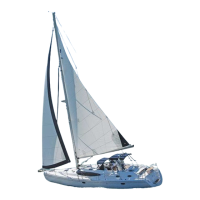nt
r
• Boatin
Safet
4.4
An
h
r
n
lin
B
t h
k
Bucket & Spon
ommonl
used spare parts
istress si
nal kit
ockin
lines
En
ine and accessor
manuals
Extra ke
s
xtr
-
t
F
n
r
Fir
t
i
ki
Flashli
ht & extra batteries
anuall
operated bil
e pum
avi
ational charts
wner’s Manual
eplacement bulbs
HF r
i
are fuel and oil filters
T
l ki
*Provided in Loose Gear Kit
US Boats onl
.1.7 Personal Flotation Devices
PFDs
There must be one United
tates
oast
uard approved
wearable personal
lotation device o
T
pe I, II, or III
or
ac
person on
oar
our
oat.
e
s must
e
n
serviceable condition and readil
accessible. A minimum
three PFDs
two wearable and one throwable
is
required re
ardless of the number of persons on board.
A
PFD T
pe I, Wearable:
This o
shore li
e
acket has the
reatest buo
anc
. It is
ective
or all waters where rescue ma
be dela
ed. Its
desi
n allows for turnin
most unconscious persons in
the water
rom
ace down position to a vertical or
ace-up
position.
B
PFD T
pe II, Wearable
s near-s
ore
uo
ant vest prov
es
ess
uo
anc
than a T
pe I PFD. It is intended
or calm inland waters
r waters where there is a chance o
quick rescue. It turns
its wearer to a face-up position as does the T
pe I PFD,
but the turnin
action is not as pronounced as the T
pe
I, and it will not turn as man
persons under the same
on
t
ons as a
pe
.
C
PFD T
pe III, Wearable
lassi
ied as a
lotation aid, this PFD allows wearers
to place themselves in a vertical or
ace-up position in
the water. T
pe III PFD has the same minimum buo
-
anc
as a
pe
.
t
as
tt
e or no turn
n
a
t
.
People participatin
in water sports o
ten pre
er this PFD
because it is intended
or use in waters where quick res-
ue is possible and it is
enerall
the most comfortable
r
ntin
w
r.
D
PFD T
pe IV, Throwable
Y
m
t
l
h
v
r
t l
t
n
thr
w
l
PFD
pe
ev
ce.
e
pe
ev
ce can
e t
rown to a
erson in the water and held b
the user until rescued.
The desi
n does not allow it to be worn. The most com-
on
pe
are
uo
ant cus
ons or r
n
uo
s.
This PFD must be immediatel
available
or use and in
rvi
l
n
iti
n.
.2 Carbon Monoxide Hazard
(See enclosed brochure concerning Carbon Monoxide poison-
ing and preventing)
s all responsible
achtsmen know, there are unseen
dan
ers when boatin
.
ne dan
er is serious enou
h
that we feel the need to specificall
brin
it to
our
attention. It is odorless
colorless
and tasteless
but
n
h
rmf
l
r f
t
l if inh
l
. It
n
m
i
ARB
N
NIXIDE
C
.2.1 Carbon Monoxide Safet
This section is intended to provide educational in
orma-
ti
n
t
r
n m
n
xi
r
l
tiv
t
t
n
t-
in
. Carbon Monoxide accumulation is affected b
boat
eometr
, hatch, window, and door openin
s, ventilation
openin
s, proximit
to other structures and boats, wind
rect
on,
oat s
ee
,
oat ma
ntenance, an
a mu
t
-
tude o
other variables. This section discusses man
o
th
n
n
l
th
t
wn
r t
tt
r
n
r
t
n
all conceivable variables. Therefore, the boat owner is
autioned not to exclusivel
rel
on it to prevent the accu-
l
ti
n
f
r
n M
n
xi
.
.2.2 What is Carbon Monoxide?
arbon Monoxide is a hi
hl
poisonous
as formed b
the
ombination o
carbon and ox
en.
ommonl
re
erred
to as C
, its chemical formula is C for carbon and
for
ox
en. C
is a colorless, odorless, and tasteless
as
that, b
itsel
, cannot be detected b
human senses.

